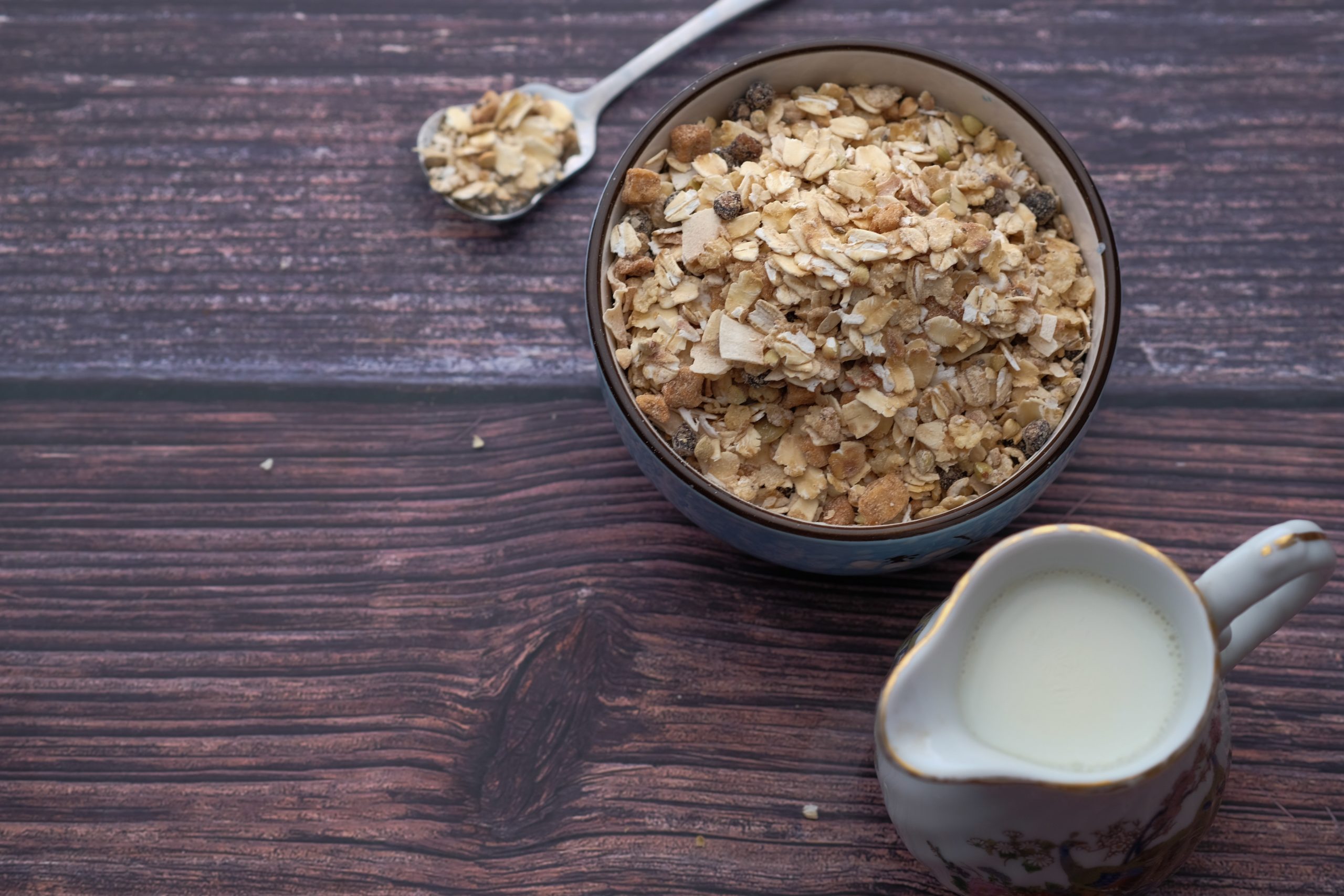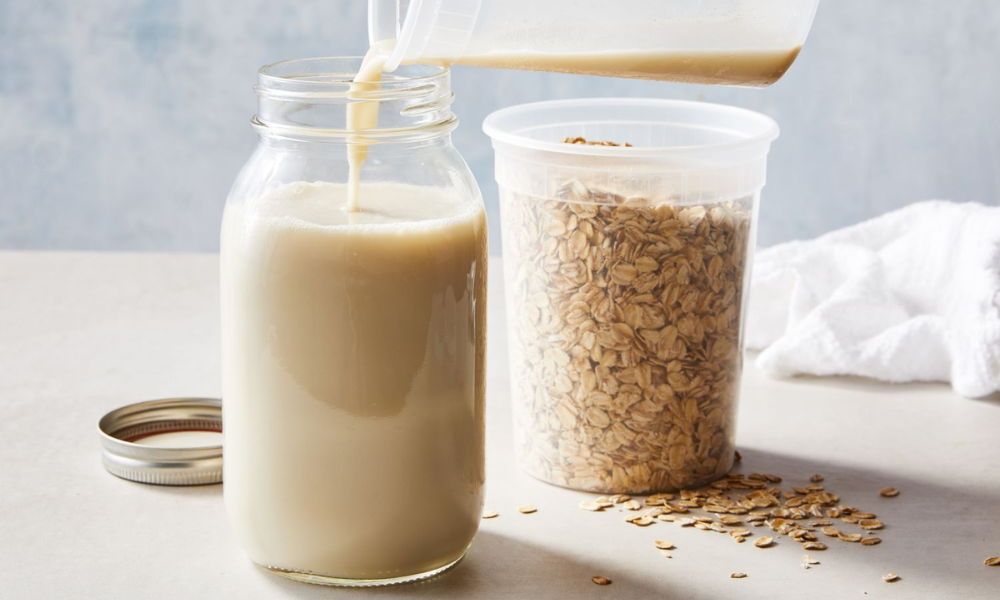A plant-based milk substitute prepared from oats and water is called oat milk. It is a well-liked option for lactose-intolerant vegans seeking a milk substitute without dairy. In addition, oat milk is a good source of fiber, vitamins, and minerals. The steps involved in turning oats into milk will be covered in detail in this article, along with the supplies and equipment required.
How is Oat Milk Made?
Before you can drink oat milk, you must understand how it is made. Here is a step-by-step guide to making oat milk at home:
Soak the oats: To soak the oats, add 2 cups of water to a bowl with 1 cup of rolled oats. Give the oats to soak for at least two hours—or even the entire night. The oats become softer and are simpler to combine as a result.
Blend the oats: Drain the soaked oats, then add 4 cups of water to a blender. At this point, you can also incorporate any extra ingredients, including flavors or sweeteners. The mixture should be smooth after 1-2 minutes of high-speed blending.
Strain the mixture: Place a cheesecloth or fine-mesh strainer over a big basin or pitcher to drain the mixture. Pour the oat mixture over the strainer gradually while pressing it through with a spoon or spatula. The remaining sediments in the strainer should be discarded.
Chill and serve: Transfer the oat milk to a jar or bottle, then put it in the fridge to chill before serving. Shake vigorously before using. In addition to being consumed on its own, oat milk can be used as a milk substitute in baking, coffee, and tea.
Note: By blending in more or less water, you can change the consistency of your oat milk. Instead of rolled oats, you can use steel-cut oats, though it can take longer for them to soak and blend. Before soaking the oats, it’s a good idea to rinse them to get rid of any dirt or debris.
Here you will learn about the ingredients in oat milk, heat processing, and the addition of carrageenan to it. You will also learn about how to store it. After you know all these facts, you can make a delicious beverage.
Ingredients in Oat Milk
Oat milk is a great plant-based drink, but you should check the ingredients before buying it. Look for milk alternatives fortified with protein, fat, and other essential nutrients. They should also be low in artificial colors and flavors. Choose unsweetened varieties to cut the sugar.
Be aware that some oat milk contains added sugar. Look for the “added sugar” row on the nutrition label. This is a sign that oat milk is processed in a way that isn’t healthy for you. Some brands also add an extra step during the production process that keeps the oats from gelling. This creates less “slim” milk.
Other oat kinds of milk contain oils. This help mimics the fat content in cow’s milk. Some brands, like Oatly, add canola oil to their blend. While canola oil has gotten a bad rap recently, it contains heart-healthy fats.
Process of Heat Processing
The process of heat processing oat milk involves drying the oat pulp, separating it, and heating it to 60degC. It is then mixed with a homogenizer, which breaks down the fat droplets into uniform droplets, providing a creamy mouthfeel. It is then bottled or packed into cartons.
Oats are a grain that grows on a plant. Its leaves and stalks are removed before they are milled to create flour. Hot water, usually around 60degC/140degF, is poured over the flour to extract all its nutrients. The result is a dense liquid containing high fiber, protein, and dietary fiber levels.
Oats can be cooked separately or mixed with other grains. They can be used in breakfast cereals, batters, extruded products, and beverages. They are low in calories, have high fiber content, and have more calcium than cow’s milk.
Carrageenan in Oat Milk
The chemical compound carrageenan has been linked to cancer and other diseases. Studies have shown it can trigger an immune response and aggravate gut inflammation. It has been implicated in several GI disorders, including ulcerative colitis. Some researchers believe it can also cause intestinal ulcers and cancer. However, the evidence is mixed, and more research is needed to determine its risk to human health.
Oat milk can be consumed cold or steamed. Using steamed oat milk when combined with coffee and similar beverages is advisable. When consumed cold, the milk will become thick and change color. In addition, the shelf life of oat milk is four to seven days.
Oat milk is a great alternative for those who have dietary restrictions and do not want to consume cow’s milk. Oat milk has many health benefits, including heart health and cholesterol. People with intolerances and allergies can also benefit from oat milk.
Reference: Rheological properties of milk-based desserts with the addition of oat gum and κ-carrageenan
How do you Store Oat Milk?
Storage of Oat Milk
When it comes to oat milk, it’s important to know the proper way to store it. Oat milk may develop mold or slime if left unattended for too long. The milk may also change color or smell bad. If you notice these changes, you should immediately discard the milk.
Oat milk is made from strained oats blended with water. Depending on the manufacturer, it can contain oil to make it smooth and a sweetener to enhance its flavor. Different companies make slightly different versions of oat milk, and the difference in the ingredients will affect the shelf life. Some brands recommend using the milk within four days, while others say you can keep it for up to 10 days.
When storing oat milk, you should keep it in a cool, dry place. The ambient room temperature will affect its shelf life, so keep the container refrigerated. A glass jar is ideal for storing the product.
Is Oat Milk Healthier Than Regular Milk?
Oat milk is a plant-based alternative made from oats and water, while traditional milk is from cows, goats, or sheep. Both oat milk and ordinary milk can be nutritious. However, they have different nutritional content and health benefits.
Oat milk is lactose-free. Therefore it’s a suitable option for lactose-intolerant or milk-allergic people. Oat milk is generally supplemented with vitamins and minerals, including vitamin D, calcium, and riboflavin. Oat milk contains fiber, which helps assist digestive health.
Oat milk is not as healthy as cow’s milk. Cow’s milk is rich in protein, which helps build and repair tissues. It has calcium, vitamin D, and other minerals. Cow’s milk is helpful for children, teens, and pregnant women with greater nutrient needs.
Oat milk is thicker and creamier than cow’s but not as rich or flavorful. Oat milk may be more expensive than cow’s milk, depending on brand and location.
Your option depends on your dietary needs and tastes. Talk to a doctor or dietician if you’re considering switching to oat milk or another plant-based alternative.
How do you Use Oat Milk?
Oat milk is an alternative plant-based milk produced from oats and water. It tastes creamy and slightly sweet and has a consistency comparable to cow’s milk. Oat milk can be used in various ways, including as a substitute for milk in coffee, tea, and baked goods, as well as on its own.
Here are a few ideas for how to use oat milk:
As a milk substitute in coffee or tea: Oat milk can be used as a milk substitute in coffee and tea, and it froths well, making it an excellent choice for lattes and cappuccinos. Substitute oat milk for cow’s milk in your coffee or tea.
In Smoothies: Oat milk, along with your choice of fruit, vegetables, and other ingredients, can be used as a base for smoothies. It gives smoothies a creamy, slightly sweet flavor and a thick consistency.
In Baking: Oat milk can be used as a milk substitute in baked goods such as muffins, cakes, and cookies. Because the natural sweetness of oat milk may be noticeable in some baked goods, it may work best in recipes that are already a little sweeter.
As a milk substitute in savory dishes: As a savory milk substitute: Oat milk can be used as a savory milk substitute in soups, sauces, and casseroles. It gives these dishes a creamy texture and a slightly sweet flavor.
As a drink: Oat milk can be enjoyed cold or heated. It is an excellent choice for those who are lactose intolerant or allergic to milk or for those looking for a plant-based milk alternative.
It is crucial to remember that oat milk may not be appropriate for everyone and may not be as nutritious as other types of milk. It is a good idea to check the nutrition label and ingredient list on the box of oat milk to determine what is in the product and to consult a healthcare practitioner or registered dietitian if you have any questions.
Is There a Drawback to Oat Milk?
People with celiac disease or non-celiac gluten sensitivity should avoid oat milk. Of all the plant-based milk variants, unflavored oat milk offers the most calories and carbs. Even though the sugar in oat milk is natural, it has a lot of carbohydrates.
Conclusion
Oat milk is a plant-based milk substitute that is naturally devoid of dairy, lactose, soy, and nuts. It is suitable for anyone with gluten intolerance or allergy when cooked using oats that have been certified gluten-free. It is also vegan.
It is common practice for commercial items to be enriched with vitamins and minerals that may be good for your bones and heart. Please make your own at home or buy an unsweetened type from the supermarket to enjoy its flavor and health benefits.

